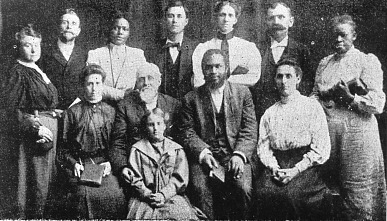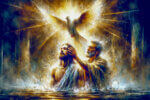Although William J. Seymour is acknowledged as the leader of the Azusa Street Revival, it was a black woman, Lucy Farrow, who provided the initial spark that ignited that revival.
No one associated with the little prayer meeting led by Seymour had spoken in tongues until Farrow, at Seymour’s request, arrived on the scene and began laying her hands on people and seeing God fill them with the Holy Spirit as in the book of Acts. She also ministered with power across the southern United States and in Liberia in West Africa. She lived out her final years in Los Angeles, where there were reported healings and remarkable answers to prayer through her ministry.
Farrow Overcomes Prejudicial Opposition
Little is known of Farrow’s early life, including the exact date of her birth. What is known is that she was born into slavery in the state of Virginia. As a black woman living in the South during Reconstruction, life would not have been easy. But in spite of being continually confronted with prejudice and injustice, she became a powerful voice in the early Pentecostal revival and provided the spark in Los Angeles that ignited the revival that has spread across the world and impacted all of Christendom. She is an example of how one can become a force for God and good even in the most difficult and aggravating circumstances.
Somewhere along the way, Farrow moved to Houston, Texas, probably around 1900, and became the pastor of a small black Holiness congregation. In Houston she would have lived under southern Jim Crow laws that were passed by southern states to keep blacks “in their place.” These laws mandated racially segregated public facilities, including separate public restrooms and drinking fountains and separate seating in restaurants and on buses. Public schools were segregated, and voting laws made it next to impossible for blacks to vote in elections.
These laws, however, were only outward manifestations of a deeply ingrained prejudice and hatred that Farrow faced every day of her life. But instead of becoming bitter and taking on a victim mentality, she allowed the faith and love of God to so fill her heart that she was able to be used by God to minister powerfully to both blacks and whites in the fledgling Pentecostal revival.
Divine Connections
While in Houston, Farrow met Charles Parham, who came there from Baxter Springs, Kan., in October 1905 to hold a meeting in Bryan Hall. Parham was preaching a message about a baptism in the Holy Spirit that would be accompanied by speaking in tongues, which he called the “Bible evidence.” He also told about the outpouring of the Holy Spirit that had occurred in his Bethel Bible College in Topeka, Kan., in January 1901, when virtually every student had been baptized in the Holy Spirit and spoken in tongues.
Farrow attended these meetings (probably in a segregated area) and was intrigued by what she heard. She acquainted herself with Parham and his wife, Sarah, and they obviously were impressed with her. When the Parhams returned to Baxter Springs, they invited her to go with them and live in their home, acting as a governess, particularly in the care of their small children. She agreed and turned the pastorate of her congregation over to a younger friend by the name of William J. Seymour.
While in the Parham home, Farrow experienced the baptism in the Holy Spirit and spoke in tongues. This proved to be a turning point in her life that positioned her to be an important catalyst in what would turn out to be the most dynamic and fastest-growing movement in modern Christendom—the modern Pentecostal-charismatic movement.
When the Parhams returned to Houston in December to begin a Bible school in the new year, Farrow returned with them and reconnected with her congregation. She also encouraged Seymour to enroll in the Bible school. Seymour followed her advice and enrolled in the school, where he learned about the baptism of the Holy Spirit and the “Bible evidence” of speaking in tongues. Although he did not receive the experience while in school, he was convinced of its veracity and began to preach it to others. Farrow, demonstrating the true humility of her character, volunteered to be the cook for the school.
Seymour Preceded Farrow to Los Angeles
Seymour was in the school for about six weeks before departing for Los Angeles to accept the invitation to pastor a small storefront church in that city. When the elders of this church rejected Seymour and his message of a Spirit baptism accompanied by speaking in tongues, he accepted an invitation from the Edward Lee family to stay in their home. He and the Lees began attending prayer meetings held in the Asberry home at 214 Bonnie Brae Street, and Seymour soon became the recognized leader. Although he had not received the baptism in the Holy Spirit himself, Seymour taught the people about it and encouraged them to pray for this Pentecostal experience.
The deep respect Seymour had for Farrow (who would have been about 10 years his senior) is shown in his desire that she teach the people in Los Angeles about the baptism in the Holy Spirit and pray for them to receive this experience. When he shared with the group about Farrow and how the baptism in the Holy Spirit had impacted her life, the group was so stirred that they took up a collection to purchase a train ticket for her to come to Los Angeles. They sent the ticket with their invitation and a prayer that the Lord would speak to her to accept their invitation.
Farrow Sparks Pentecostal Revival in Los Angeles
Probably out of her deep sense of need, Farrow had developed a radical dependence on God and a rare sensitivity to His Holy Spirit. This dependence on God characterized every part of her life and ministry. She did not have an “assembly line” approach in praying for people but only prayed as she was prompted by the Holy Spirit. This sort of radical dependence on God and sensitivity to the Spirit would characterize the revival that would break forth through her ministry in Los Angeles.
Farrow arrived in Los Angeles probably in late March and was taken to the Lee home, where she would be hosted. Shortly after her arrival, Edward Lee arrived home from work and met Farrow for the first time. Lee wsa so hungry for the baptism in the Holy Spirit that, after a brief introduction, he pleaded, “Sister, if you will lay your hands on me, I believe I will get my baptism right now.” Farrow humbly replied, “I cannot do it unless the Lord says so.”
Shortly thereafter, while eating the evening meal, Farrow laid down her fork and pushed her chair from the table. She arose and walked around the table to Lee and said, “The Lord tells me to lay my hands on you for the Holy Ghost.” She then laid her hands on Lee, who immediately fell out of his chair and, while lying on the floor, began speaking in tongues.
Revival Breaks Forth
That same evening, the Lees and Farrow departed for the prayer meeting at the Asberry home with their hearts overflowing with the presence and joy of the Lord. As Lee walked through the door, he lifted his hands and began speaking in tongues. The power of God fell on those present, and several fell to the floor and began speaking in tongues. Different gifts of the Spirit began to manifest, and the meeting lasted through the night.
Word spread quickly that God was pouring out a new Pentecost on Bonnie Brae Street, and people began to come from every direction. The house filled with people, and the crowd overflowed onto the porch and into the yard. One participant said, “By the next morning there was no way of getting near the house.”
Realizing they needed more space, they searched and found an old abandoned building in downtown Los Angeles at 312 Azusa Street. They moved the prayer meeting to that location and had their first meeting on April 14, 1906. For the next three years, the meeting ran around the clock as thousands flocked to Azusa Street from across America and other nations as well.
Revival in Houston
After the move to Azusa Street, Farrow remained in Los Angeles for another four months, ministering with Seymour and providing a much-needed stability in the early days of revival. In August, she departed for Virginia, planning from there to go to Liberia, from where her ancestors had been brought as slaves to America.
On her journey eastward, she stopped in Houston and preached in Parham’s summer camp meeting. The large audience, mostly white, was electrified as she told about the revival that was underway in Los Angeles. She then prayed for many to be baptized in the Holy Spirit and, again, as in the book of Acts, they would break forth speaking in tongues as she laid her hands on them. One participant said, “She had an amazing gift for laying hands on people and them receiving the baptism in the Holy Spirit.”
Revival in Virginia and Africa
Farrow lived by faith, having no settled fund from which to draw but trusting God to meet every need as she walked in obedience for Him. From Houston she traveled on to Virginia and then in Portsmouth held a series of meetings that lasted several weeks. It was reported that about 200 were saved and 150 received the baptism in the Holy Spirit. Sensing an urgent call to Africa but realizing the powerful work that had begun in Portsmouth, Farrow contacted Seymour and asked that a replacement be sent so she could continue on in her mission to Africa.
After help arrived from Los Angeles, Farrow traveled to New York and then sailed for Africa. She settled in Johnsonville, about 25 miles from the capital of Monrovia, from where she carried on a ministry of preaching, teaching, praying for the sick and leading people into the baptism in the Holy Spirit. It was reported that many were brought to Christ during her short stay in that country.
Final Years in Los Angeles
Farrow returned to Los Angeles and lived out her final years in a small “faith cottage” located behind the Azusa Street Mission. Many visited her there to receive her wisdom and prayers. Many testified as being healed, baptized in the Holy Spirit or having received a “greater” infilling of the Spirit through her prayers. The time and circumstances surrounding her death are unknown.
Lucy Farrow is just one of many Christian women whose lives and accomplishments have been ignored or diminished by historians. The vision of the International Christian Women’s Hall of Fame, now merged with God’s Word to Women, is to write these women back into history so that the present generation can learn and be inspired by their examples. If you would like to know more about the Hall of Fame and God’s Word to Women, go to www.icwhp.org and www.godswordtowomen.org.
Dr. Eddie L. Hyatt is a seasoned minister of the gospel, having served as a pastor, minister, missionary and professor of theology in the U.S. and Canada. Hyatt’s website is eddiehyatt.com.








Leave a Comment
You must be logged in to post a comment.